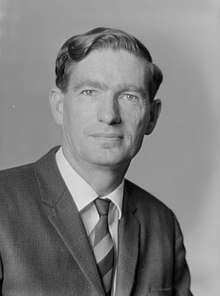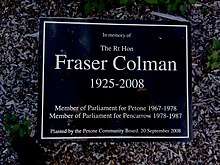Fraser Colman
| The Right Honourable Fraser Colman QSO PC | |
|---|---|
 | |
| 10th Minister of Immigration | |
|
In office 8 December 1972 – 12 December 1975 | |
| Prime Minister |
Norman Kirk Bill Rowling |
| Preceded by | David Thomson |
| Succeeded by | Frank Gill |
| Member of Parliament for Pencarrow Petone (1978–1987) | |
|
In office 1967–1987 | |
| Preceded by | Michael Moohan |
| Succeeded by | Sonja Davies |
| Personal details | |
| Born |
23 February 1925 Wellington, New Zealand |
| Died |
11 April 2008 Lower Hutt, New Zealand |
| Political party | Labour |
| Spouse(s) | Noeline Allen |
| Children | 4 |
Fraser MacDonald Colman QSO PC (23 February 1925 – 11 April 2008) was a New Zealand politician of the Labour Party. He represented the electorates of Petone from 1967 to 1978, and then when Petone was renamed, Pencarrow from 1978 to 1987, when he retired. He was the cabinet minister chosen to represent New Zealand in 1973 on its warships during their protest against the nuclear weapons testing carried out by France.
Early life
Colman was born in Wellington on 23 February 1925, one of five children.[1] He attended primary school in Wellington before his family moved to Paraparaumu, where he went to Horowhenua College.[1] Upon leaving school he found employment as a boilermaker at the firm of William Cables; he worked in that profession for 13 years.[1]
He soon became active in the union movement, becoming a shop steward. He joined the Labour party, organising and distributing pamphlets and writing for the Labour Party newspaper, The Southern Cross.
Political career
| New Zealand Parliament | ||||
| Years | Term | Electorate | Party | |
| 1967–1969 | 35th | Petone | Labour | |
| 1969–1972 | 36th | Petone | Labour | |
| 1972–1975 | 37th | Petone | Labour | |
| 1975–1978 | 38th | Petone | Labour | |
| 1978–1981 | 39th | Pencarrow | Labour | |
| 1981–1984 | 40th | Pencarrow | Labour | |
| 1984–1987 | 41st | Pencarrow | Labour | |
He served as campaign manager for Henry May in the Onslow electorate in 1954. In 1955 he became assistant general secretary of the Labour Party. He held the position until he was persuaded to stand for Labour in the by-election for the Petone electorate in 1967 following the death in office of Michael Moohan, its existing MP.[1] He was elected in the 15 April 1967 by-election.[2] He held Petone until it was abolished in 1978.[3] He represented the Pencarrow electorate, which replaced Petone, from 1978 to 1987.[1]
Third Labour Government
He was a Cabinet Minister in the third Labour Government. In the cabinet of Norman Kirk, he held the positions of Minister of Mines (1972–1974),[4] Minister of Immigration (1972–1974),[4] Associate Minister of Labour, and Associate Minister of Works.[5] In the cabinet of Bill Rowling, he was Minister of Mines, Minister of Immigration and Postmaster-General (all 1974–1975).[6]
Following the defeat of the Labour Party he held the position of Opposition Spokesman on Energy.[5]
Mururoa
In 1973, the government decided to dispatch a Royal New Zealand Navy frigate to protest against French nuclear testing on Mururoa Atoll in the South Pacific. It was decided that a cabinet minister should accompany the frigate to demonstrate the seriousness of the New Zealand government’s position. Norman Kirk put all the Cabinet ministers' names into a hat and drew out the name of Colman. He departed from Auckland on 25 June aboard the Otago, which reached Mururoa a month later where he witnessed the first atmospheric test. Colman transferred to the Canterbury when it arrived to relieve the Otago on 25 July, from which he witnessed the second French atmospheric test.[7]
Fourth Labour Government
In the fourth Labour Government, he again served as a cabinet minister holding the posts of Minister of Works and Development,[8] Minister in Charge of the Earthquake and War Damages Commission, and Associate Minister of Energy.[1]
Life after politics

Colman retired from Parliament at the 1987 election. He was replaced in Pencarrow by Sonja Davies.[1] He was subsequently appointed as chairman of the New Zealand Fire Service Council for a three-year term.[1]
Private life
He married Noeline Allen in 1958 after first meeting her in 1954.[1] They moved to Wainuiomata in 1959,[5] where they built a home and spent the remainder of their life there.[1] They had four daughters: Acacia, Ann, Lynda and Jeanette.
He had a stroke in 1991. Another stroke in 1999 removed his ability to speak. He was survived by his wife and three daughters; Acacia had died before him.[1]
Decorations, awards and memberships
- Member of Her Majesty's Most Honourable Privy Council. 1986.
- Companion of the Queen's Service Order for public services, 1992 New Year Honours[9]
- Life member of the Wellington Rugby League Club.[1]
Honorific eponym
- Fraser Colman Grove, a street in Wainuiomata is named after him.[10]
See also
Notes
- 1 2 3 4 5 6 7 8 9 10 11 12 "Colman the ideal politician". The Hutt News. 22 April 2008. p. 66. Retrieved 17 August 2012.
- ↑ Wilson 1985, p. 190.
- ↑ Wilson 1985, p. 270.
- 1 2 Wilson 1985, p. 92.
- 1 2 3 "?". Wainuiomata Times. 17 April 2008. p. 3. Check date values in:
|accessdate=(help);|access-date=requires|url=(help) - ↑ Wilson 1985, p. 93.
- ↑ "Nuclear testing in the Pacific - nuclear-free New Zealand". Ministry for Culture and Heritage. 12 March 2012. Retrieved 17 August 2012.
- ↑ Wilson 1985, p. 98.
- ↑ London Gazette (supplement), No. 52768, 30 December 1991. Retrieved 8 January 2013.
- ↑ Hutt City Council. Proposed New Street Name – Fraser Colman Grove. Report No. WCB2007/1/2. http://www.huttcity.govt.nz/Documents/meetings/boards/wainuiomata/28.02.07/reports/ProposedNewStreetName-FraserColmanGrove.pdf. Retrieved 24 April 2008.
References
| Wikimedia Commons has media related to Fraser Colman. |
External links
| Political offices | ||
|---|---|---|
| Preceded by Roger Douglas |
Postmaster-General 1974–1975 |
Succeeded by Hugh Templeton |
| New Zealand Parliament | ||
| New constituency | Member of Parliament for Pencarrow 1978–1987 |
Succeeded by Sonja Davies |